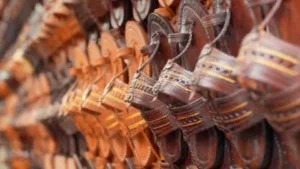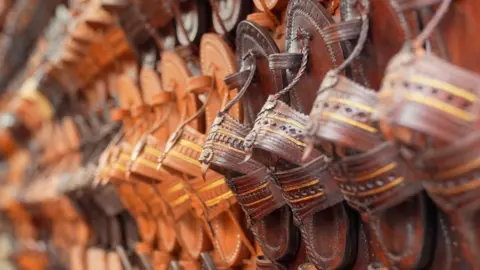The small town of Kolhapur in Maharashtra, India, has recently found itself at the center of a fierce cultural debate as local artisans raise their voices against redoubtable luxury fashion brand Prada. The incident that sparked this outcry relates to Prada’s launch of a new line of sandals that bear a striking resemblance to traditional Kolhapuri sandals—a footwear style deeply rooted in the region’s history. The artisans argue that Prada has appropriated their designs without due credit or compensation, raising significant questions about cultural ownership and ethical representation in fashion.
The Kolhapuri sandal, characterized by its unique craftsmanship and style, has a rich history dating back to the 12th century. Craftsmen in Kolhapur have been handcrafting these sandals for generations, relying on traditional techniques passed down through centuries. Yet, despite this cultural legacy, many artisans face dire financial challenges. The local industry has dwindled drastically, with only about 5,000 artisans remaining in the cottage industry, struggling against mass production and mechanization.
Sadashiv Sanake, a 58-year-old artisan, highlights the challenges faced by his community as he shares the painstaking labor that goes into creating each pair of sandals. He recalls learning the craft as a child and mentions that only eight to ten pairs can be made in a day, each selling for a modest $8-10. Such low earnings reflect a broader trend where artisans are forced to contend with poor working conditions and low wages, inadequate to sustain themselves and their families. When approached with Prada’s expensive versions of sandals, he raised a skeptical eyebrow, questioning why they could command such high prices, rhetorically asking, “Do they have gold in them?”
The controversy erupted when Prada showcased its new sandal line during Milan Fashion Week without acknowledging its connections to Kolhapuri styles. Artisans immediately took to social media, accusing the brand of cultural appropriation. The sentiment was fuelled by public outcry over the perceived erasure of the artisans’ contribution to fashion. In response to the backlash, Prada issued a statement that recognized the origins of the sandals, but many believe this acknowledgment was not enough to compensate the artisans for their loss of recognition.
Local industry associations and politicians have joined forces with artisans in calling for fair treatment and better recognition of their craft. The artisans aim not just for credit but also for a rightful share in the profits generated by the global fashion giant. The issue transcends mere appropriation; it raises questions surrounding the rights of marginalized communities who have historically been left out of economic opportunities.
The history of Kolhapuri sandals is intricately tied to the marginalized Chamakar community, also known as chamars, who originally crafted these sandals. Professor Kavita Gagrani from the New College in Kolhapur elaborates on how royal patronage in the early 20th century helped the craft flourish, yet many artisans today still work under difficult circumstances. Recently, increasing costs for leather and competition from synthetic alternatives have placed further strain on these traditional artisans.
In light of the controversy, some experts propose improving the institutional framework to protect artisans’ rights better. Kolhapuri sandals were awarded the Geographical Indication (GI) status by the Indian government in 2019, aimed at safeguarding the name and authenticity within India. Nevertheless, international laws do not offer similar protection against aesthetic imitation, which is where many fear exploitation could continue.
As legal avenues are explored, industry representatives like Lalit Gandhi advocate for patenting the Kolhapuri sandal design, aiming to establish precedents for future cases. However, the crux of the solution lies in fostering a cultural renaissance that values and respects traditional craftsmanship. As designer Ritu Beri aptly points out: “It’s about ethical recognition. India must push for royalty-sharing and co-branding.” Such changes may better preserve the cultural heritage while ensuring the artisans’ professionals are respected and rewarded.
In the aftermath of the controversy, the future remains uncertain. A legal plea has been filed in court, demanding compensation from Prada and seeking a structured collaboration with the artisans. It is noteworthy that with rising interest in Kolhapuri sandals post-controversy, there is hope that these artisans will receive the acknowledgment they deserve. Whether or not this will translate into tangible benefits for them hinges on how the legal and fashion industries navigate the complex intersections of cultural heritage in a globalized world. The pressure remains on both sides for meaningful dialogue and action as discussions continue.











